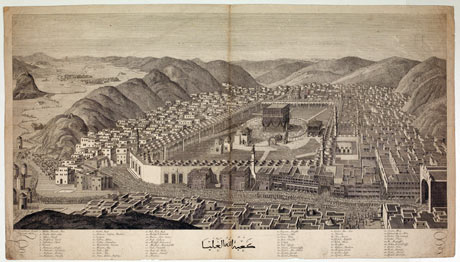I was unable to take my mother on the Muslim pilgrimage to Mecca, so I did what I thought would be the next best thing: I took her to the British Museum’s hajj exhibition
It has long been my mother’s ambition to complete the hajj. The pilgrimage to Mecca is one of the five pillars of Islam – and thus an obligation for all Muslims. My father often talked about going to Mecca and my parents were planning a trip. He sadly died suddenly from a heart attack in 1995 and in the years since my mother talked often about her desire to make the pilgrimage, and both my brother and I repeatedly promised that we would take her. We never did.
Although I had grown up with images of the hajj, actually going to Mecca never felt like a priority to me: I worried about the heat, the crowds and I had selfish reasons for nervousness about the ritual where men have the hair shaved off their heads. And then my mother had a stroke and now, at the age of 78, she has trouble walking on her own and is no longer physically strong enough to withstand the great heat and huge crowds who assemble in Mecca. I have always felt guilty about not having taken my mum to Mecca when she was fitter and so when I heard about the British Museum’s hajj exhibition I was determined to take her there. It wasn’t Mecca but perhaps it would be the next best thing.
Hajj: Journey to the Heart of Islam is the first British show devoted to the pilgrimage and it charts the history of the hajj through space and time. I visited the exhibition with both my mother and my wife Bridget and, perhaps inevitably, we all had different responses to the maps, objects and artefacts. My mother was most animated by the footage of pilgrims leaving on ships in the sub-continent bound for Saudi Arabia. She started telling me stories of men who had left her village near Lahore, heading to Mecca on foot. She was also deeply moved to see the clothes that pilgrims wore – the white robes that imply that in Mecca all Muslims no matter the gender, skin colour or social status are equal. Bridget – raised in a culture where spirituality was more often associated with solitude – was intrigued by a version of spirituality where one is buoyed up on a sea of humanity.
As for myself, I experienced a range of reactions. There was a part of me – the part that recalls seeing images of the hajj hung on the walls of so many of my parents’ friends’ houses – that enjoyed learning more about the stories behind the hajj. Listening to my mother explain the origins of the holy Zam Zam water and the ritual of throwing stones at the devil was to be reminded that for Muslims of her generation Islam consists mostly of stories told through the ages. Many of those stories – and rituals – actually predated Islam – something only touched upon in the exhibition.
More on this article at Guardian.co.uk. Article by: Sarfraz Manzoor
